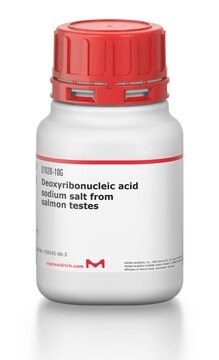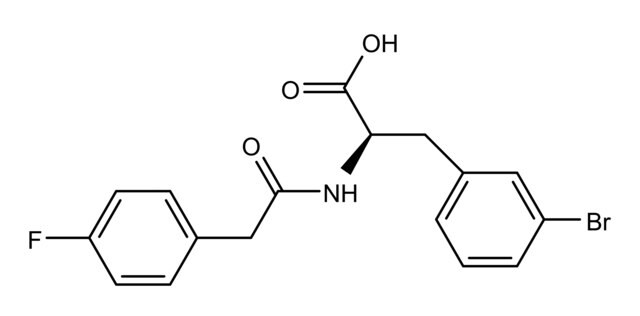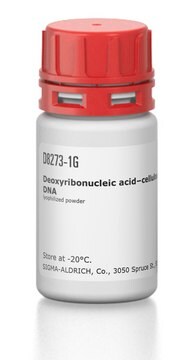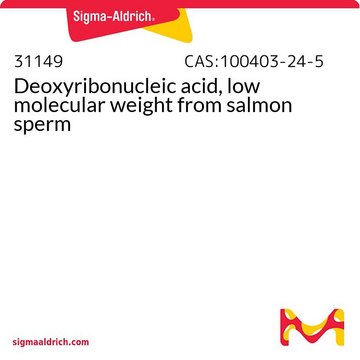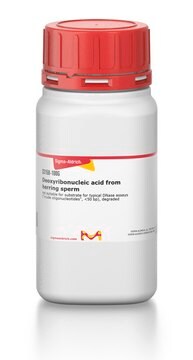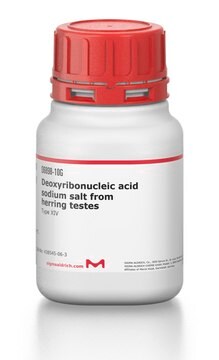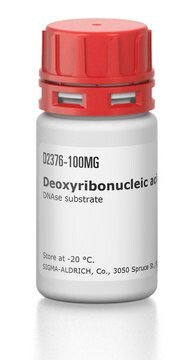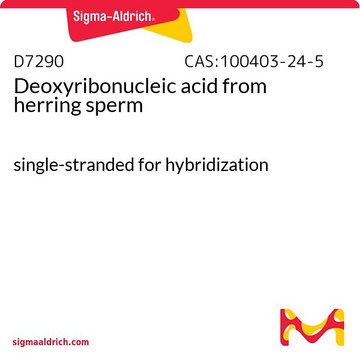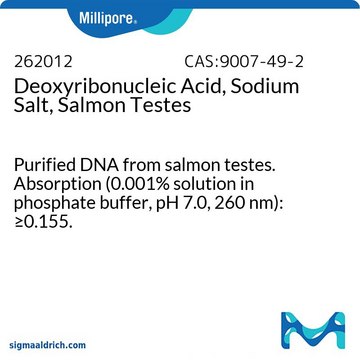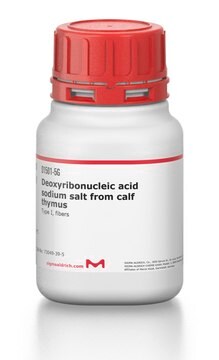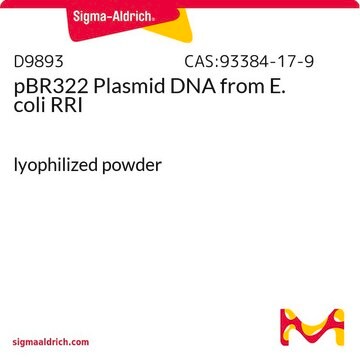D4889
Deoxyribonucleic acid sodium salt from Escherichia coli strain B
Genomic, unsheared
Sinonimo/i:
DNA
Autenticatiper visualizzare i prezzi riservati alla tua organizzazione & contrattuali
About This Item
Numero CAS:
Numero CE:
Numero MDL:
Codice UNSPSC:
41106310
eCl@ss:
32160414
NACRES:
NA.52
Prodotti consigliati
Grado
for molecular biology
Livello qualitativo
Forma fisica
lyophilized powder
PM
>45 kb
Temperatura di conservazione
2-8°C
Cerchi prodotti simili? Visita Guida al confronto tra prodotti
Categorie correlate
Descrizione generale
Escherichia coli strain B is most widely studied DNA after k-12. The genomes of E coli strain B and k-12 show differences in the IS sequence elements. Strain B have B-islands and express O-specific side-chain LPS. The product is unsheared genomic DNA.
Specificità
50% GC; Tm = 90.5 °C
Applicazioni
The DNAs are particularly useful for genomic analysis, including PCR, library construction in bacteriophage λ, and in heterologous pre-hybridization and hybridization protocols.
Deoxyribonucleic acid sodium salt from Escherichia coli strain B has been used for:
Deoxyribonucleic acid sodium salt from Escherichia coli strain B has been used for:
- PCR reactions of genomic DNA of Gardnerella vaginalis
- nick translation and radiolabeling of dNTP
- generating standard curve for 16S rDNA quantification
- transfecting neutrophils
- testing the extraction methods
Definizione di unità
One unit will yield an A260 of 1.0 in 1.0 ml of 1 mM Tris-HCl, pH 7.5, with 1 mM NaCl and 1 mM EDTA (1 cm light path).
Nota sulla preparazione
Purified by anion exchange chromatography, dialyzed against a solution of 1 mM sodium chloride, 1 mM EDTA and 1 mM Trizma HCl, pH 7.5 and lyophilized at a concentration of approx. 2 units per mL. Approx. 20 A260 units per mg DNA. % GC is the percentage of G/C base pairs. Tm is the temperature at the midpoint of the thermal denaturation profile.
Risultati analitici
Analyzed by gel electrophoresis and visualization after ethidium bromide staining, with single predominant band of 45 kB or greater.
Altre note
DNA in solution will reanneal on standing at room temperature so it is recommended to boil the solution for 10 minutes and then cool on ice for at least 5 minutes prior to use.
Prodotti correlati
N° Catalogo
Descrizione
Determinazione del prezzo
Codice della classe di stoccaggio
11 - Combustible Solids
Classe di pericolosità dell'acqua (WGK)
WGK 3
Punto d’infiammabilità (°F)
Not applicable
Punto d’infiammabilità (°C)
Not applicable
Dispositivi di protezione individuale
Eyeshields, Gloves, type N95 (US)
Certificati d'analisi (COA)
Cerca il Certificati d'analisi (COA) digitando il numero di lotto/batch corrispondente. I numeri di lotto o di batch sono stampati sull'etichetta dei prodotti dopo la parola ‘Lotto’ o ‘Batch’.
Possiedi già questo prodotto?
I documenti relativi ai prodotti acquistati recentemente sono disponibili nell’Archivio dei documenti.
I clienti hanno visto anche
Jong-Pyo Kang et al.
Archives of microbiology, 201(1), 99-105 (2018-09-28)
A novel bacterial strain designated DCY116T was isolated from ginseng-cultivated soil in Gochang-gun, Republic of Korea. Strain DCY116T, belongs to the genus Rhizobium, and is closely related to Rhizobium yantingense H66T (98.3%), Neorhizobium huautlense S02T (98.2%), Rhizobium soli DS-42T (98.1%)
Vitalii Patsula et al.
Nanotoxicology, 13(4), 510-526 (2019-02-02)
Innovative nanotechnology aims to develop particles that are small, monodisperse, smart, and do not cause unintentional side effects. Uniform magnetic Fe3O4 nanoparticles (12 nm in size) were prepared by thermal decomposition of iron(III) oleate. To make them colloidally stable and dispersible
S Farzaneh et al.
The Journal of antimicrobial chemotherapy, 40(6), 789-795 (1998-02-14)
Klebsiella oxytoca strain HB60 is highly resistant to cefoperazone and aztreonam (MICs = 128 mg/L). It produces a chromosomally encoded beta-lactamase of pI 5.7 which was highly efficient against penicillins, first-generation cephalosporins and cefoperazone, a non-oxyimino third-generation cephalosporin. Aztreonam and
Xuewen Pan et al.
Methods (San Diego, Calif.), 41(2), 206-221 (2006-12-27)
Analysis of genetic interactions has been extensively exploited to study gene functions and to dissect pathway structures. One such genetic interaction is synthetic lethality, in which the combination of two non-lethal mutations leads to loss of organism viability. We have
Genomic comparisons among Escherichia coli strains B, K-12, and O157: H7 using IS elements as molecular markers
Schneider D, et al.
BMC Microbiology, 2(1), 18-18 (2002)
Il team dei nostri ricercatori vanta grande esperienza in tutte le aree della ricerca quali Life Science, scienza dei materiali, sintesi chimica, cromatografia, discipline analitiche, ecc..
Contatta l'Assistenza Tecnica.